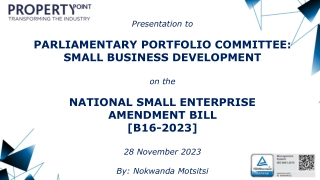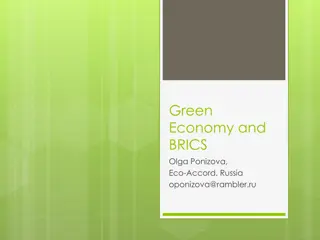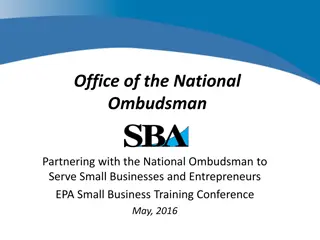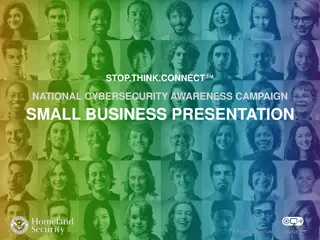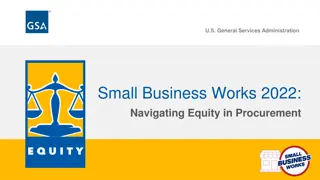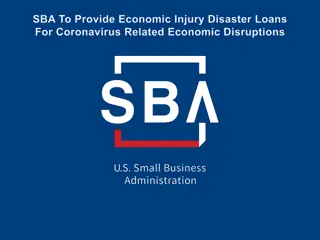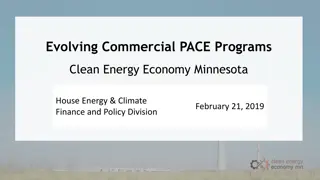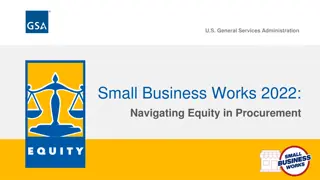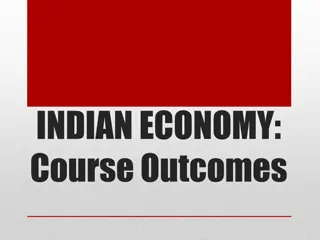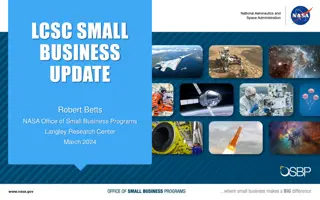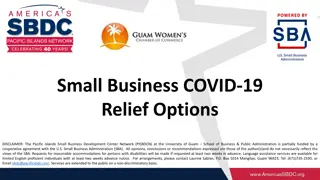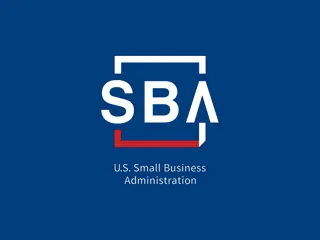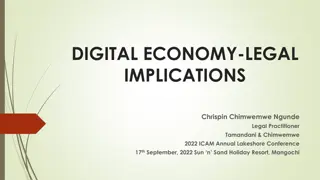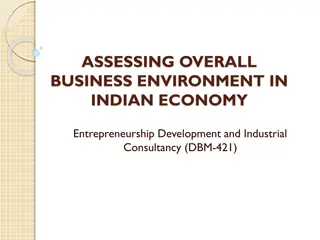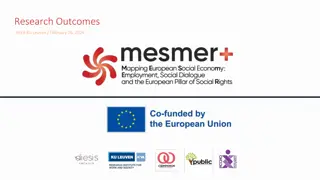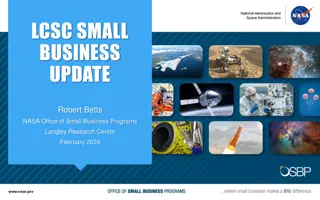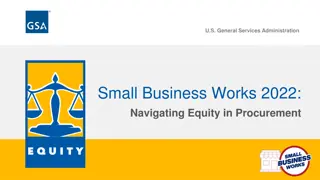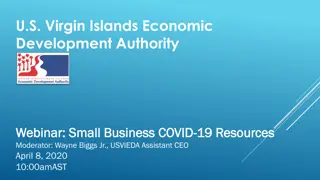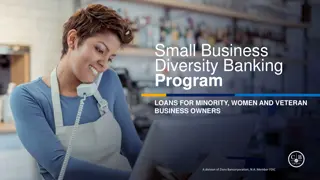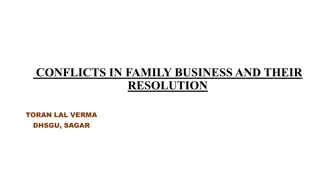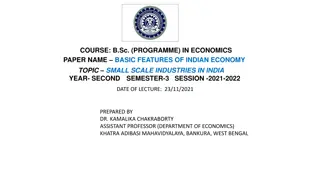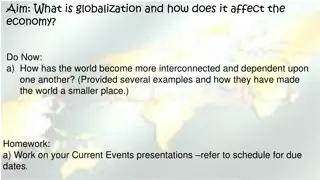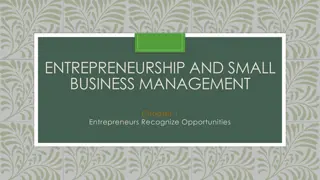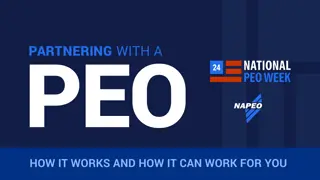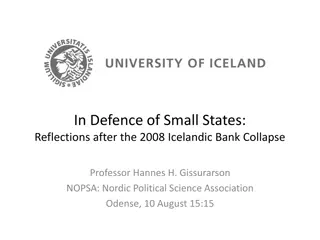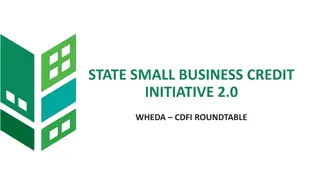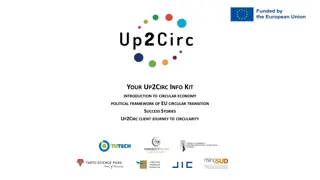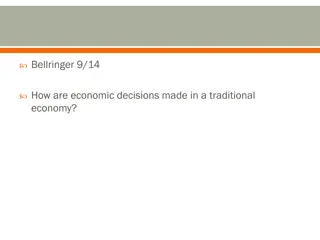Understanding Small Businesses in the Economy
Small businesses are vital components of the economy and can be defined by measures of size or economic/control criteria. This content explores the definition, criteria used to measure size, and types of small businesses such as family enterprises and franchises.
Download Presentation

Please find below an Image/Link to download the presentation.
The content on the website is provided AS IS for your information and personal use only. It may not be sold, licensed, or shared on other websites without obtaining consent from the author. Download presentation by click this link. If you encounter any issues during the download, it is possible that the publisher has removed the file from their server.
E N D
Presentation Transcript
Part two: creation of new venture 3.1 Small Business as Basic components of Economy 3.2 What is basic business idea 3.3 Steps in business setting 3.4 Developing a Business Plan 1
What is small business? There are two approaches to define small Business. They are: 1. By some measure of size 2. using an economic /control definitions/criteria A small business is a privately owned and operated business or A small business typically has a small number of employees. 2
Measure of Size Criteria Examples of criteria used to measure size are: 1. Number of employees 2. Sales volume 3. Asset size 4. Insurance enforce 5. Volume of deposits Although the first criteria located above, employee, is the most widely used yardstick; the best criteria in any given case depends upon the user s purpose. 3
Measure of Size Criteria To provide a clear image of the small firms, the following general criteria for defining a small business are suggested: A). Financing of the business is supplied by one individual or a small group. b) Except for its marketing function, the firm s operations are geographically localized. c) Compared to the biggest firms in the industry is small d) The number of employees in the business is usually fewer than 100 4
Economic /Control Criteria The economic /control definition cover: a)Market share:- The characteristics of a small firm s share of the market is that it is not large enough to influence the prices of national quantities of goods sold to any significant extent. b)Independence:- Means that the owner has control of the business himself. c)Personalized management:- It implies that the owner activity participates in all aspects of the managements of the business, and in all major decisions-making processes. There is no delegation of authority. All three of these characteristics must be satisfied if the business is to rank as a small business. 5
Types of small business 1. Family Enterprises Family owned business varies widely and can include retail stores, contracting businesses, small manufacturing firms, and restaurants among others. In the absence of a successor, the life of a venture is limited to the working life of its founder. Succession is a serious problem. 2. Personal service Firms(PSF) 3. Franchise:-The franchisee may receive Francis help, training, a protected market, and technical assistance with matters such as site selections, purchasing, accounting, and operations management. 6
Why are small business important to economy? They make exceptional contributions as they provide New job opportunity. Introduce innovations-many scientific breakthrough originated with small organization. Photocopies, etc. Stimulating economic competitions. Reasons for more rapid growth of small firms in most developed countries. 1. New technologies, such as numerically controlled machine tools, may permit efficient production on a smaller scale 2. Greater flexibility is required as a result of increased global competitions 3. Consumers may be coming to prefer personalized products over mass produced goods. 7
Causes for small business failure Incompetence- The owners simply mayn t know how to run the enterprise. Unbalanced experience- do not have rounded experience in the major activities of business production. Lack of managerial experience- Do not know how to manage production. Lack of experience in the line- the owner has entered a business field in which he or she has very little knowledge. Neglect- the owner does not pay sufficient attention to the enterprise. Fraud- involves intentional misrepresentations or deception (purchasing materials or goods for him/herself with the company s money) Disaster- refers to some unforeseen happening or act of God (eg. Robberies and extended strikes.) 8
The following are specific managerial causes of small business failure Inadequate records- unable to establish an adequate record keeping system. Expansion beyond resources Lack of information about customer Failure to diversify market Lack of marketing research. Legal problems Nepotism- favoritism toward family members One person management Lack of technical competence Absentee management the owner stayed away for long period 9
Strength and weakness of small business Strength 1. Independence Most small business owners enjoy being their own boss, they like the freedom to do things than way. 2. Financial opportunities Many small business owners make more money running their own company than they would be working for someone else. 3. Community services if the person has reason to believe the public will pay for such output, he/she will start a company to provide it. 10
Strength and weakness of small business 4. Job security when one owns a business, job security is ensured. 5. Family employment (benefits) create the employment in the family higher moral and trust occur in family-run business 6. Challenge. They want to win or lose on their own abilities the challenge gives them psychological satisfaction 11
Weaknesses 1. Sales fluctuations in some months sales are very high, while in other they drop off dramatically. The individual must balance cash inflows with cash outflows. 2. Competition- Owning a business is the risk of competition (eg. Restaurants) 3. Increased responsibilities- owner is often a bookkeeper, accountant sales person, personnel manager. 4. Financial loses- when the owner makes all major decisions 6. Risk of failure- the ultimate risk the small business owner manger faces is failure. 12
What is Business Idea? A business idea is the response of a person/organization to solving an identified problem or to meeting perceived needs in the environment (markets, community, etc.). Business idea: thinking of a goal for the unit in long run rather than to look for the immediate tomorrow. This long-term thinking is called business idea. Finding a good idea is the first step in transforming the entrepreneur s desire and creativity into a business 13 opportunity.
Cont 14
What is basic business idea? Businessmen/businesswomen should think of long-term goal/profit. The basic business idea is to meet the broadest needs of the customers, and has the long life perhaps from 5-50 years. The basic business idea facilitates choice of product under an overall plan. 15
What is basic business idea? The product line is relatively narrow and has a shorter life. The product line consists of different families of product. A unit with a basic business idea for example packaging can manufacture any of the following groups of the products: Glass bottles Plastic packages Metal packages Aluminum packages Paper or wood packages. The product range includes different size of the product with in the product line, in the examples given above different size of glass bottles can be manufactured for varied applications. 16
What is basic business idea? The product is one item of the product range having different specifications like size, material used and weight, etc. In a dynamic business scheme, one has to carefully watch is one of the basic idea degenerating as regards. Its ability to generate quick returns. Its ability to permit quick changes in the products. 17
CONT To be a successful entrepreneur, one major determinant factor is the choice of a good business idea. To select the best business idea, the following steps needs to be pursued. a. Identify your problem b. Define your objectives c. Identify, develop and analyze the possible alternative d. Select the best alternative in light of the specific criteria set to the better fulfillment of the objective. 18
Why Generate Business Ideas? Business ideas need to respond to market needs/consumer needs Business ideas help entrepreneurs to stay ahead of the competition Business ideas use technology to do things better Business ideas are needed because the life cycles of products are limited Business ideas can help specific groups of people (elderly, disadvantaged, those with disabilities) Business ideas help to solve natural resource scarcity, pollution and depletion/reduction 19
Sources of Business Ideas Good business ideas are a prerequisite for initiating a new business venture. Sources: Hobbies/Personal Interests Personal Skills and Experience Media (newspapers, magazines, TV, Internet) Business Exhibitions Surveys Customer Complaints Natural scarcities and pollution Changes in Society Brainstorming Being Creative Ideas from overseas (Global) Potential Imports 20
Evaluating a Business Idea Each business idea should be evaluated in terms of: Present market: the size of the presently available market must provide prospects of immediate sales volume to support operations Market growth: There should be prospects for rapid growth and high return on invested capital Costs: Some of the costs of production will include: a) start up costs, b) costs of raw material inputs, c) labor costs, d) selling costs, e) efficiency of production processes, f) service, warranty, customer complaints and g) patents and licenses. Business risks: Market stability in economic cycles, Technological risks, Import competition Size and power of competitors, Legislation and controls, Time required to generate profit 21
SWOT analysis The SWOT approach compels individuals to think or reason out systematically and analytically the important factors strengths, weakness, opportunities, and threats. Strength: is an inherent capacity, which an organization can use to gain strategic advantage over its competitors. Weakness: is an inherent limitation or constraint, which creates a strategic disadvantage Opportunity: refers to any factor that offer promise or potential for moving closer or more quickly towards the firms goal 22
Threat: is any factor that may limit or impede the business in the pursuit of its goals. Threats can result from: inability to get access to new technology industry entry or exit barriers Legislation
Steps in business setting 1. The first key to success in any manufacturing activity is to select the right product. These must be examined with a view to assess: a.The marketing aspects b.Technical aspects c. Financial aspects 2. Having selected a product, a detailed project report to be prepared. This will cover the following aspects. a.A detailed estimate of demand is to be made. b. Technical specifications of the process should be carefully studied. c. The equipment required and their sources are to be specified d.Requirement of space. 26
Cont 3. Implementation of the detailed project report. Includes: a.Deciding on form of ownership and registration b. Obtaining finance ,Obtaining license c. Establishing necessary infrastructures 4. Once all the required authorizations and sanctions have been obtained, simultaneous action is to be taken for the following. Pre-commissioning requirement a. Ordering machinery from suppliers b. Obtaining utilities like power and water connections after constructions of shed, if necessary. c. Recruitment of staff, d. Arranging supplies of materials e. Arranging for distribution of the products 27
Cont 5. Once these are complete, the plant is ready for commissioning trial run may be made. Commissioning of plant, Includes: a.Trial run of machineries b.Promotional activity for the product c.Introduce the product to the market and obtain feedback 6. The unit is then ready for commercial production. a. Commercial production This is all about the feasibility study +pre & after implementation 28
Developing a Business Plan WHAT IS A BUSINESS PLAN? A business plan is a comprehensive set of guidelines for a new venture. A business plan is also called a feasibility plan that encompasses the full range of business planning activities. A business plan would present your basic business idea and all related operating, marketing, financial and managerial considerations. What ever the name, it should lay out your idea, describe where you are, point out where you want to go, and how you propose to go there. 29
The Purpose of Business Plan 1.It can help the owner/manager crystallize/focus his/her idea and quantified on paper. 2.It can help the owner/manager set objectives and give him a yardstick against which to monitor performance. 3.It can also use as a vehicle to attract any external finance needed by the business. E.g. to get fund 30
5. It can convince investors that the owner/manager has identified high growth opportunities. 6. It entails taking a long-term view of the business 7. It emphasizes the strengths and recognizes the weaknesses of the proposed venture. 8. The plan can alert the entrepreneur to sources of possible danger 31
Who Produce the Business Plan? Managers:, Owners:, Lenders: WHY THE BUSINESS PLANS ARE PRODUCED? Assessing the feasibility and viability of the business/project: it is in every ones interests to make mistakes on paper, hypothetically testing for feasibility, before trying the real thing. Setting objectives and budgets: having a clear financial vision with believable budgets is a basic requirement of everyone involved in a plan. Calculating how much money is needed: a detailed cash flow with assumptions is vital ingredient to precisely quantify earlier the likely funds required. 32
The Format of a Business Plan 1. Where are we now? An analysis of the current situations of the market place, the competitions, the business concept and the people involved. It will include any historical background relevant to the positions to date. 2. Where do we intend going? Qualitative expression of the objectives, quantifiable targets will clarify and measure progress towards the intended goals. 3. How do we get there? Implementing of accepted aims is what all the parties to a plan are interested in as a final result. 33
Components of Business Plan I. Analysis of the current situation (where are we now?) 1. Identification of the business a. Introduction - relevant history and background - Proposed date for commencement of trading /beginning of a plan b. Names - name of the business and trading name - name of the managers/owners c. Legal identity - company/partnership/sole-trade/cooperative - details of share or capital structure 34
Cont d. Location -address-registered and operational - brief details of premises. e. Professional advisers, -Accountants, solicitors, bank 2. The key people a. Existing management- Outline of background experience, skills and knowledge. -Names of the management team b. Future requirement -gaps in skills and experience and how they will be filled - future recruitment intentions 35
Cont 3. The nature of the business a. Product(s)or service(s)-Description and applications -Key suppliers -Planned developments of product or service b. Market and customers Definition of target market, classification of customers - Trend in market place c. Competition- description of competitors; strength and weakness of the major competitors. 36
Cont II. Future Direction (where do we intend going?) i. Strategic Influence -SWOT Analysis 1. Opportunities and threats in the business environment Socio-economic and Technological trends Legislation, politics and Competition 2. Strengths and weaknesses In its industry, In the general environment: ii. Strategic direction: 1. Objectives- general and specific 2. Policies- guidelines and rules 3.Activities- action plans and timetable of key activities 37
Cont III. Implementation of Aim (how do we get there?) 1. Management of resources a) Operation:-premises, materials, equipment, insurance, management information system. b) People/Human resource/- employment practices, recruitment, team management, training etc.. 2. Marketing plan a)Competitive edge- unique selling point of business (Critical products or service characteristics or uniqueness in relation to competitors) b) Marketing objectives - specific aims for product or service in the market place c) Marketing methods- product, pricing, promotion, distributions=4ps 38
Cont 3. Money: financial analysis a. Funding requirement- start up capital, working capital, asset capital, timing of funds required, security offered. b. Profit and loss:-- 3 years forecast, sales variable costs, profit, overheads, net profit c. Cash flow:-- 3 years forecast, receipts, payments, monthly and cumulative cash flow d. Balance sheet - use of funds, source funds 39
Creativity, innovation and Entrepreneurship Creativity is thinking new things, and innovation is doing new things Researchers believe that entrepreneurs succeed by thinking and doing new things or old things in new ways . Entrepreneurship = creativity + innovation The nurturing of small firm formation and growth has become increasingly important to the health of developed economies in general, and to the creation of new innovative industrial sectors in particular. 40
Cont 41
What does it take to be creative ? Initial Idea A Willingness to engage in difficult work Customers who are willing to buy your idea 42
The creative process Idea Germination: This is the seeding stage of a new idea. It is the stage where the entrepreneur recognizes that an opportunity exists. The idea germination takes place according to interest, curiosity of the entrepreneur 43
The creative process Preparation: On the basis of the idea, the entrepreneur starts looking for the answer to implement the idea. If the idea is to launch a new product or service then market research is conducted and the entrepreneurs foresee the future of the product 44
The creative process Incubation Process: Give the subconscious time to reflect on the information (daydream, relax, etc.) The entrepreneur starts thinking about the idea and implementation in his sub-conscious mind Study the problem/opportunity in a wholly different environment E.g. studying the pros and cons of manufacturing the product before he had launched it. 45
The creative process Illumination In this period, the idea re-surfaces in realistic way. The entrepreneur comes out with viable plan to give practical shape by collecting raw material, arranging funds, policy making for the implementation of idea. Verification Also called the validation or testing stage. Validate the idea is useful (conduct experiments, prototypes, etc.) This is the most difficult phase of creativity as obstacles begin to appear. This is the developing stage in which knowledge is developed into application 46
How to form and develop Technology based ventures? Government policies: Credit programs with State-subsidized rates Share programs by Government venture-capital companies Grants by the Government, especially for creating jobs and for research Security programs by the Government for taking over part of the risk of the credit institutions for enterprises Advisory services. 49
How to form and develop Technology based ventures? Other support activities for enterprises with both public and private sector involvement, include: Business consulting services: Assistance with business development, developing business plans, tax advice, and so forth; Technical consulting services: More specialized services are provided such as: Networking assistance between enterprises and science Technology organizations, Technology transfer, The exchange of similar experiences and The identification of potential for cooperation 50




